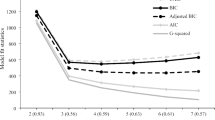Abstract
Rationale. Clinical observations and recent findings suggested different acceptance of morphine and heroin by intravenous drug users in opiate maintenance programs. We postulated that this is caused by differences in the perceived effects of these drugs, especially how desired and adverse effects of both drugs interacted.
Objectives. We measured the desired and adverse effects of high doses of injected morphine and heroin in patients to determine the causal interactions between both types of effects and test the hypothesis of a differential mechanism of action.
Methods. Thirty-three patients (five females, 28 males; mean duration of previous street heroin use 10.7 years, mean age 30.1 years) were randomly allocated double-blind to the substance groups. The average daily dose per participant in the heroin condition (n=17) was 491 mg, in the morphine condition (n=16) 597 mg. The observation period lasted 3 weeks; an average of 70 injections was received. After each injection of either substance, various aspects of drug effects were recorded systematically. Ratings were summarized into the factors "euphoria" and "adverse effects". Time series models were computed for each participant on the basis of the factor scores, using vector autoregression (VAR).
Results. A highly significant difference between the substances was found in the interaction between "euphoria" and "adverse effects". Adverse effects of heroin preceded higher euphoria, whereas adverse effects of morphine preceded subsequent lower euphoria. Additionally, the finding of a higher level of adverse effects in morphine was replicated.
Conclusions. Results point to different mechanisms of action of the two opioids when the perceived drug effects are evaluated in a field setting. This may explain the better acceptance of heroin in opiate-assisted treatment of intravenous drug patients. The method used can be a valuable tool for the comparison of substance groups other than opioids.
Similar content being viewed by others
Author information
Authors and Affiliations
Additional information
Electronic Publication
Rights and permissions
About this article
Cite this article
Tschacher, W., Haemmig, R. & Jacobshagen, N. Time series modeling of heroin and morphine drug action. Psychopharmacology 165, 188–193 (2003). https://doi.org/10.1007/s00213-002-1271-3
Received:
Accepted:
Issue Date:
DOI: https://doi.org/10.1007/s00213-002-1271-3



